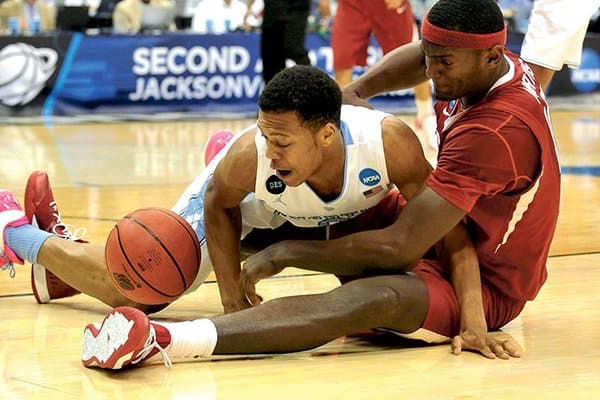Arkansas becomes the first modern-era program to play one foe three straight times in the same round.
This evening, the No. 8 seed Razorbacks take the court against a heavily favored, No. 1 North Carolina squad in the Round of 32 in the NCAA Tournament. This feels a bit like deja vu for Hog fans, who have seen their Razorbacks match up against UNC in this same round in the program’s last two tournament appearances. Neither go-around — one in 2008, the other in 2015 — was close.
When coincidences like this happen to a specific fanbase, it’s enticing for those fans to believe said “crazy thing” happens only to them, that they have been somehow specially smited by the basketball gods. Here’s the thing, though: Such singularity really is happening to to the Razorbacks.
With today’s game, Arkansas becomes the first program since the NCAA Tournament expanded to 64 teams — or 32 teams, for that matter — to play another program in three straight appearances in the same round. To put this in context, consider that heading into this 2017 NCAA Tournament, there have been about 110 “rivalries” in which one program has played another at least three times over the 78-year history of the NCAA Tournament.
In none of those cases, in the modern era, has any program undergone what’s happening to Arkansas. Before expansion to a 32-team field, this “three-peat” did occur in the 1950s through early 1960s, when the total pool of teams was much smaller and programs tended to more often play geographic neighbors in the first round. In this era, the NCAA Tournament fluctuated between 22 and 25 entries. Below are the other occurrences, according to an analysis of mcubed.net:
Seattle: From 1953 to 1956, met Idaho State each year in the first round (won three, lost one).
Utah State: From 1962 to 1964, met Arizona State each year in the first round (won two, lost one).
Oregon State: From 1962 to 1964, met Seattle* each year in the first round (won two, lost one).
Tonight’s game against North Carolina presents a daunting challenge for the Hogs. The speedy Tar Heels hold advantages on paper across the board. They are, for starters, most strong (in rebounding) where Arkansas is the most weak. And their best player, the 6-foot-8 Justin Jackson, is the kind of rangy, skilled wing for which Arkansas simply has no answer.
While the Hogs regularly throw out four players in the 6-foot-1 to 6-foot-3 range in Dusty Hannahs, Jaylen Barford, Manny Watkins, Daryl Macon and Anton Beard, North Carolina has only have one starter under 6-foot-6 . Simply put, North Carolina represents the kind of gold standard to which Arkansas is aspiring: a team more skilled, longer and more athletic.Hannahs is hardly using hyperbole when during a media session this weekend he noted, “This is David and Goliath.”
Statistically, the chances of an Arkansas upset are slim. But, from all outside appearances, the players and coaches firmly believe they can do it. They have, after all, seen infinitesimal odds overcome before. If not, they wouldn’t be on the cusp of playing UNC three straight times in the same round in the first place.
*The star of a few of those early 1960s Seattle teams was North Little Rock’s Eddie Miles, whom former Hog basketball coach Glen Rose wanted to make the first black Razorback. I write more about that story and others in my upcoming book African-American Athletes in Arkansas: Muhammad Ali’s Tour, Black Razorbacks and other Forgotten Stories.



